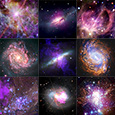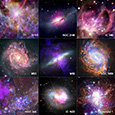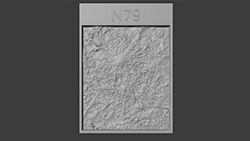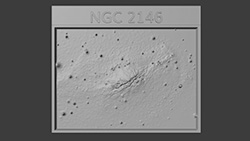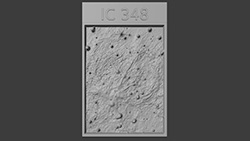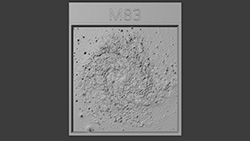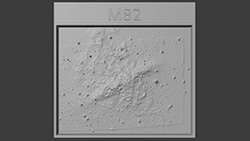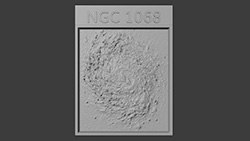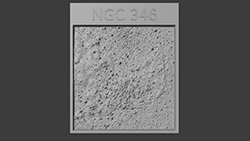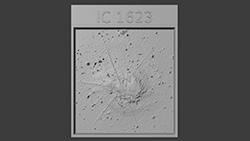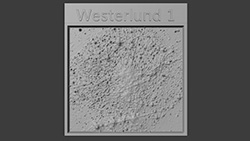CXC Home | Search | Help | Image Use Policy | Latest Images | Privacy | Accessibility | Glossary | Q&A
Montage of 9 Images:
A new eye-catching compilation of images is being released that features data from NASA’s Chandra X-ray Observatory along with a host of other telescopes including NASA’s James Webb Space Telescope, Hubble Space Telescope and more.
As NASA’s flagship X-ray telescope, Chandra observes many different exciting phenomena that produce energetic and spectacular action. There are nine objects in this new space-based light pageant, ranging from nearby pockets of star formation to distant galaxies with giant black holes.
As NASA’s flagship X-ray telescope, Chandra observes many different exciting phenomena that produce energetic and spectacular action. There are nine objects in this new space-based light pageant, ranging from nearby pockets of star formation to distant galaxies with giant black holes.
1
N79Credit: X-ray: NASA/CXC/Ohio State Univ/T. Webb et al.; IR: NASA/ESA/CSA/STScI; Image Processing: NASA/CXC/SAO/J. Major
N79 is a giant region of star formation in the Large Magellanic Cloud, a small satellite neighbor galaxy to the Milky Way. Chandra sees the hot gas created by young stars, which helps astronomers better understand how stars like our Sun formed billions of years ago.
X-rays from Chandra (purple) and infrared data from Webb (blue, grey and gold)
X-rays from Chandra (purple) and infrared data from Webb (blue, grey and gold)
2
NGC 2146Credit: X-ray: NASA/CXC/SAO; Optical: NASA/ESA/STScI and NOIRLab/NSF/AURA; Infrared: NSF/NOAO/KPNO; Image Processing: NASA/CXC/SAO/L. Frattare
NGC 2146 is a spiral galaxy with one of its dusty arms blocking the view of the galaxy’s center from Earth’s perspective. X-rays from Chandra show double star systems and hot gas that is being driven away from the galaxy by supernova explosions and winds from giant stars.
X-rays from Chandra (pink and purple), optical data from Hubble and the Las Cumbres Observatory in Chile and infrared data from NSF’s Kitt Peak (red, green and blue)
X-rays from Chandra (pink and purple), optical data from Hubble and the Las Cumbres Observatory in Chile and infrared data from NSF’s Kitt Peak (red, green and blue)
3
IC 348Credit: X-ray: NASA/CXC/SAO; Infrared: NASA/ESA/CSA/STScI; Image Processing: NASA/CXC/SAO/J. Major
IC 348 is a star-forming region in our Milky Way galaxy. The wispy structures that dominate the image are interstellar material that reflect the light from the cluster’s stars. The point-like sources in Chandra’s X-ray data are young stars in the cluster developing there.
X-rays from Chandra (red, green and blue) and Webb infrared data (pink, orange and purple)
X-rays from Chandra (red, green and blue) and Webb infrared data (pink, orange and purple)
4
M83Credit: X-ray: NASA/CXC/SAO; Optical: NASA/ESA/AURA/STScI, Hubble Heritage Team, W. Blair (STScI/Johns Hopkins University) and R. O'Connell (University of Virginia); Image Processing: NASA/CXC/SAO/L. Frattare
M83, a spiral galaxy like the Milky Way, is turned face-on toward Earth. This provides an unfettered view of the entire galaxy that is often impossible with different orientations. Chandra has detected the explosions of stars, or supernovas, and their aftermath across M83.
X-rays from Chandra (red, green and blue) with ground-based optical data (pink, gold and gray)
X-rays from Chandra (red, green and blue) with ground-based optical data (pink, gold and gray)
5
M82Credit: X-ray: NASA/CXC/SAO; Optical/IR: NASA/ESA/STScI; Image Processing: NASA/CXC/SAO/J. Major
M82 is a so-called starburst galaxy where stars are forming at rates tens to hundreds of times higher than normal galaxies. Chandra sees supernovas that produce expanding bubbles of multimillion-degree gas that extend for millions of light-years away from the galaxy's disk
X-rays from Chandra (purple) with Hubble optical data (red, green, and blue)
X-rays from Chandra (purple) with Hubble optical data (red, green, and blue)
6
NGC 1068Credit: X-ray: NASA/CXC/SAO; Optical/IR: NASA/ESA/CSA/STScI (HST and JWST); Radio: NSF/NRAO/VLA; Image Processing: NASA/CXC/SAO/J. Schmidt and N. Wolk
NGC 1068 is a relatively nearby spiral galaxy containing a black hole at its center that is twice as massive as the Milky Way’s. Chandra shows a million-mile-per-hour wind is being driven from NGC 1068’s black hole and lighting up the center of the galaxy in X-rays.
X-rays from Chandra (blue), radio data from NSF’s VLA radio data (pink), and optical data from Hubble and Webb (yellow, grey and gold)
X-rays from Chandra (blue), radio data from NSF’s VLA radio data (pink), and optical data from Hubble and Webb (yellow, grey and gold)
7
NGC 346Credit: X-ray: NASA/CXC/SAO; IR/Optical: NASA/ESA/HST; UV: NASA/ESA/STScI/Catholic Univ of America; Image Processing: NASA/CXC/SAO/J. Major, and K. Arcand
NGC 346 is a young cluster home to thousands of newborn stars. The cluster’s most massive stars send powerful winds and produce intense radiation. X-rays from Chandra reveal output from massive stars in the cluster and diffuse emission from a supernova remnant, the glowing debris of an exploded star.
X-rays from Chandra (purple) with optical and ultraviolet from Hubble (blue, brown and gold)
X-rays from Chandra (purple) with optical and ultraviolet from Hubble (blue, brown and gold)
8
IC 1623Credit: X-ray: NASA/CXC/SAO; IR: NASA/ESA/CSA/STScI; Image Processing: NASA/CXC/SAO/L. Frattare and J. Major
IC 1623 is a system where two galaxies are in the process of merging. As the galaxies collide, they trigger new bursts of star formation that glow dramatically in certain kinds of light. The merging galaxies may also be in the process of forming a supermassive black hole.
X-rays from Chandra (magenta) with Webb infrared data (red, gold and gray)
X-rays from Chandra (magenta) with Webb infrared data (red, gold and gray)
9
Westerlund 1Credit: X-ray: NASA/CXC/SAO; Optical: NASA/ESA/STScI; IR: NASA/ESA/CSA/STScI; Image Processing: NASA/CXC/SAO/L. Frattare
Westerlund 1 is the biggest and closest “super” star cluster to Earth. Data from Chandra and other telescopes is helping astronomers delve deeper into this galactic factory where stars are vigorously being produced. Observations from Chandra have uncovered thousands of individual stars pumping out X-ray emission into the cluster.
X-rays from Chandra (pink, blue, purple and orange) with Webb infrared data (yellow, gold and blue) and Hubble optical data (cyan, grey and light yellow)
X-rays from Chandra (pink, blue, purple and orange) with Webb infrared data (yellow, gold and blue) and Hubble optical data (cyan, grey and light yellow)
Tactile Products
1
3D Printable Files: N79 (3D Print Credit: NASA/CXC/A. Jubett, using software by Tactile Universe/N. Bonne & C. Krawczyk & Blender)
N79 is a giant star forming region in the Large Magellanic Cloud. Here, ridged shafts of light bursting out of a central raised orb cut through misty web-like clouds.
2
3D Printable Files: NGC 2146 (3D Print Credit: NASA/CXC/A. Jubett, using software by Tactile Universe/N. Bonne & C. Krawczyk & Blender)
The spiral galaxy known as NGC 2146 is shown here from the side. The galaxy resembles a streaky, tilted disk of puckered cloud with a less-distinct haze at the center.
3
3D Printable Files: IC 348 (3D Print Credit: NASA/CXC/A. Jubett, using software by Tactile Universe/N. Bonne & C. Krawczyk & Blender)
IC 348 is a star-forming region in our Milky Way galaxy. This other-worldly image resembles a tangle of hair dotted with dozens of raised orbs in various sizes.
4
3D Printable Files: M83 (3D Print Credit: NASA/CXC/A. Jubett, using software by Tactile Universe/N. Bonne & C. Krawczyk & Blender)
M83 is a spiral galaxy. Here, the disk-shaped galaxy is viewed face-on, with mottled arms spiraling around a central protruding core.
5
3D Printable Files: M82 (3D Print Credit: NASA/CXC/A. Jubett, using software by Tactile Universe/N. Bonne & C. Krawczyk & Blender)
In this plate, the tilted, disk-shaped M82 starburst galaxy is viewed edge-on. Bursting out of the core in opposite directions, perpendicular to the disk, are giant, hazy gas clouds that extend for thousands of light-years.
6
3D Printable Files: NGC 1068 (3D Print Credit: NASA/CXC/A. Jubett, using software by Tactile Universe/N. Bonne & C. Krawczyk & Blender)
NGC 1068 is a relatively nearby spiral galaxy. This neighbor is viewed face-on, with its tightly packed arms and faint clouds swirling around a hazy bump of a core. There, million-mile-per-hour winds swirl around a glowing black hole.
7
3D Printable Files: NGC 346 (3D Print Credit: NASA/CXC/A. Jubett, using software by Tactile Universe/N. Bonne & C. Krawczyk & Blender)
NGC 346, a cluster of newborn stars, is depicted here by hundreds of spiky dots, and thousands of tightly-packed tiny specks, that together fill up a billowy cloud.
8
3D Printable Files: IC 1623 (3D Print Credit: NASA/CXC/A. Jubett, using software by Tactile Universe/N. Bonne & C. Krawczyk & Blender)
IC 1623 is a system where two galaxies are in the process of merging. Backed by tendrils, swirls of specks, and gauzy ribbons, two plateaued clusters meet, sending out starlike rays of light.
9
3D Printable Files: Westerlund 1 (3D Print Credit: NASA/CXC/A. Jubett, using software by Tactile Universe/N. Bonne & C. Krawczyk & Blender)
Westerlund 1 is Earth's biggest and closest neighboring "super" star cluster. Here, scores of bumpy orbs and tiny specks pack the otherwise empty space, surrounded by a haze, and mottled clouds.
Return to: Chandra Captures Razzle-Dazzle Across Space in New Images (July 23, 2025)


